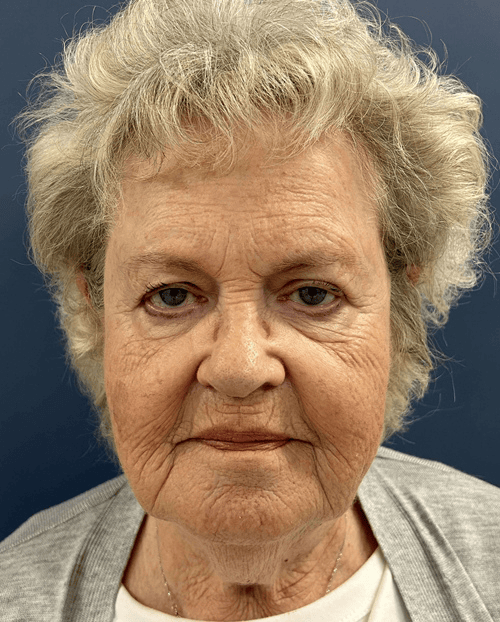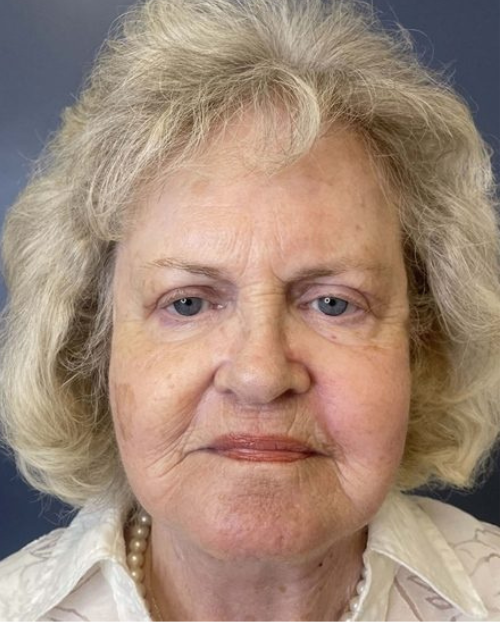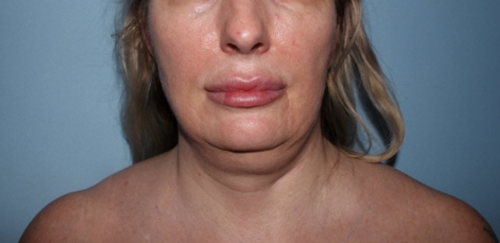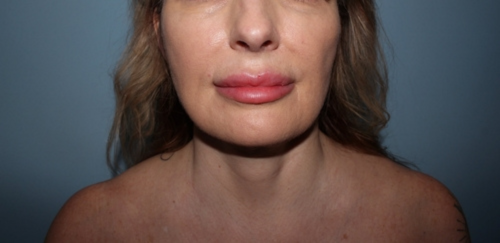This 78-year-old woman had a history of heart problems and required a pacemaker. Otherwise, she was generally healthy just had high blood pressure but had never had a heart attack. She was hopeful to have a full facelift and upper blepharoplasty with concerns primarily related to her neck. To undergo this type of surgery, either general anesthesia or sedation is usually recommended. When patients have pacemakers, the device either has to be turned off with appropriate precautions or the surgeon uses a special bipolar cautery device to control bleeding to avoid interference with the pacemaker. The patient’s cardiologist was not comfortable allowing her to undergo general or IV sedation anesthesia. The patient still was motivated to have improvements. Because a full facelift or neck lift would be very difficult in these circumstances, the patient chose a more limited option. She underwent a direct neck lift which involves an incision in the midline of the neck with direct removal of excess skin fat and improvement in muscle alignment. This was performed with a bipolar cautery device with appropriate precautions but with only local anesthesia. She also had upper blepharoplasty done at a separate procedure just a few weeks later to limit her risks. Although the improvements in her neck are less dramatic than a full facelift, she was quite pleased with the changes.
A direct neck lift is usually not a great option for women as the incision and scar is more noticeable in the neck as women have much smoother skin than men who can hide the scar in their hair-bearing beard. However, with appropriate skin closure techniques, scar management and even future laser treatments to the scar, the scars can be acceptable even in the properly selected patient. Usually an older woman with looser skin.
Next Steps
If you’re considering a breast implant removal surgery in Raleigh, NC, and want personalized advice about your suitability, recovery, risks and results, I’d be happy to meet with you for a consultation. Let’s work together to help you achieve your best results—safely and beautifully.
To book a consultation please fill in the contact form or phone the office on (919) 307-8585.

Meet Dr. Glenn Lyle
Board Certified Plastic Surgeon
Dr. Glenn Lyle, a board-certified plastic surgeon, has been proudly serving the Raleigh, NC, community at Lyle Plastic Surgery and Aesthetics Center since 2002. With a deep passion for helping patients reclaim their confidence, Dr. Lyle specializes in transformative breast surgery and body contouring procedures. Whether addressing the effects of weight loss, pregnancy, or aging, his expert care and artistic approach empower individuals to look and feel their best. Dr. Lyle is dedicated to creating beautiful, natural results that reflect each patient’s personal journey and goals.
Further Reading
- Read more about Neck Lift in Raleigh, NC
- Read more about Eyelid Lift in Raleigh, NC
- Read more about How Nitrogen Plasma Regenerates Your Skin Naturally – About NeoGen
- Read more Dr Glenn Lyle’s Blog Page on Isolated Neck Lift-Improves Sagging Neck Line
- Read more Dr Glenn Lyle’s Blog Page on Upper Blepharoplasty is a Powerful Procedure
- Read more Dr Glenn Lyle’s Blog Page on Isolated Neck Lift-Improves Sagging Neck Line
- Read more Dr Glenn Lyle’s Blog Page on My Ellevate : Minimally Invasive Neck lift-Great Technology with Limitations





